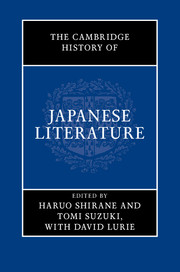
- Cited by 2
-
Cited byCrossref Citations
This Book has been cited by the following publications. This list is generated based on data provided by Crossref.
Pollock, Sheldon 2018. Small Philology and Large Philology. Comparative Studies of South Asia, Africa and the Middle East, Vol. 38, Issue. 1, p. 122.
Denecke, Wiebke and Busby, Keith 2022. Literature. p. 345.
- Publisher:
- Cambridge University Press
- Online publication date:
- January 2016
- Print publication year:
- 2015
- Online ISBN:
- 9781139245869
- Subjects:
- Literature, Area Studies, Asian Literature, Asian Studies
- Collection:
- Cambridge Histories - Literature


